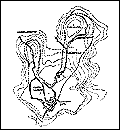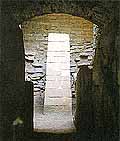Archaeological
Service
in Vetulonia (GR)
Directed by Dr.M.Cygielman

H O M E
| Tuscan Archaeological Service | Archaeological excavations in Vetulonia (GR) Directed by Dr.M.Cygielman |  H O M E |
 This important Etruscan town, which ancient sources attribute with having
transmitted the symbols of power to Rome (the lictor's fasces, the curule chair
and the praetexta), was discovered and excavated by Isadoro Falchi from 1880
onwards. The extremely rich necropolis dating from Villanovian and Easternized
times (9th-early 6th centuries B.C.), has offered up many important archaeological
finds that testify to its vitality and its flourishing network of contacts and
trade with all the most important cities in the Near East, Egypt, Greece,
Sardinia, Central Europe and Italy.
This important Etruscan town, which ancient sources attribute with having
transmitted the symbols of power to Rome (the lictor's fasces, the curule chair
and the praetexta), was discovered and excavated by Isadoro Falchi from 1880
onwards. The extremely rich necropolis dating from Villanovian and Easternized
times (9th-early 6th centuries B.C.), has offered up many important archaeological
finds that testify to its vitality and its flourishing network of contacts and
trade with all the most important cities in the Near East, Egypt, Greece,
Sardinia, Central Europe and Italy.
A series of important barrow tombs were discovered that can be visited today (Diavolino II, Pietrera, Belvedere, Fibula d'oro and Poggio Pelliccia - near Giuncarico), as well as a cycle of sculptures in stone in the tumulus of Pietrera; dating from the second half of the 7th century B.C., this cycle can now be found in the National Archaeological Museum in Florence and is considered one of the oldest groups of Etruscan sculpture as yet known.
A large number of
archaeological sites related to the settlement in Hellenistic times (3rd-1st
century B.C.) can also be visited near the modern town: Poggiarello Renzetti,
Costia dei Lippi and Costa Murata, which show an extensive demographic expansion,
with houses, warehouses, paved roads, etc.
